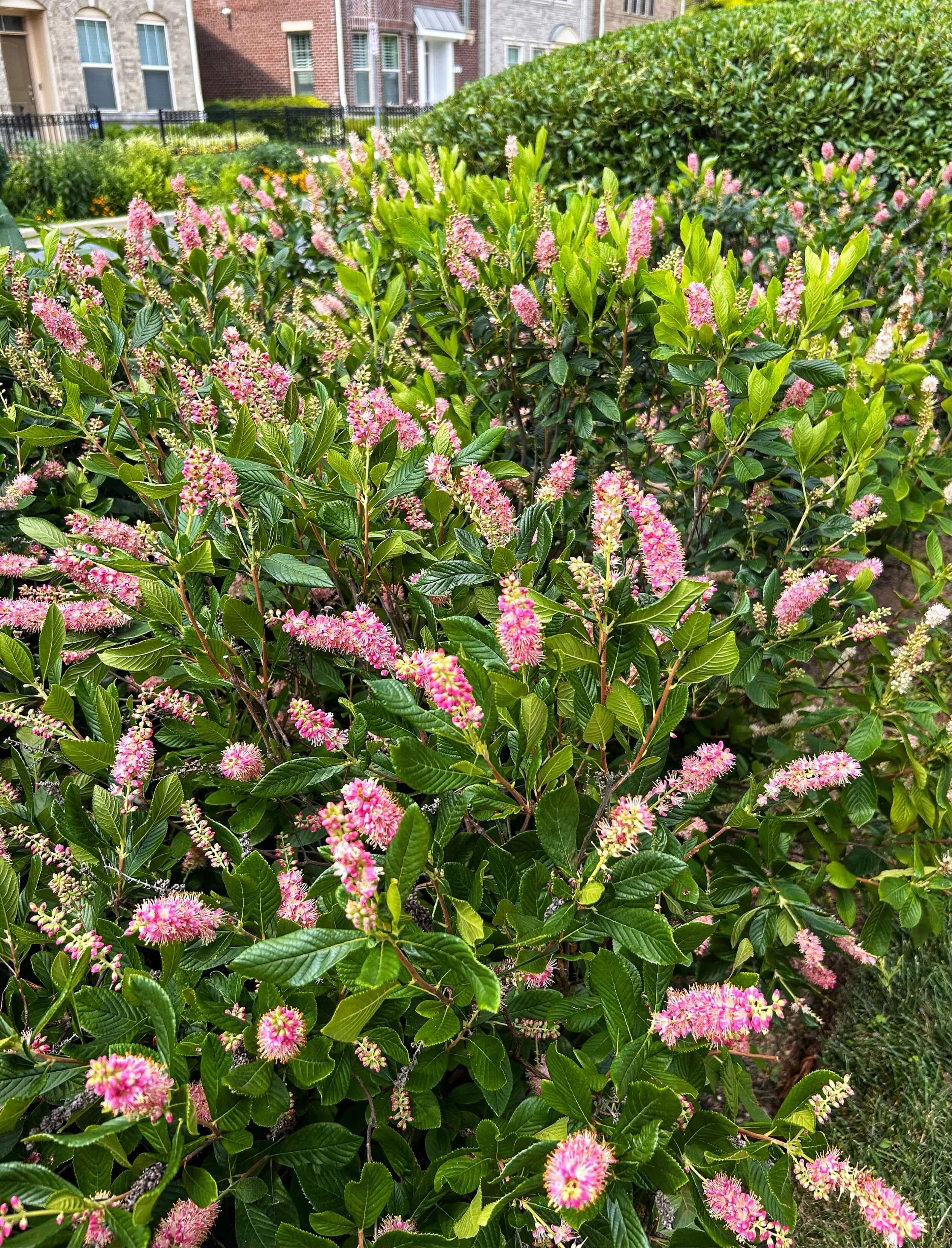Summersweet Clethra
Summersweet Clethra Is the Perfect Addition to Your Pollinator Garden
Bees, butterflies and insects flock to the fragrant summer blooms of this native, low-maintenance shrub.
Summersweet Clethra (Clethra alnifolia) is a rewarding addition to any garden or landscape. In summertime, the fragrant panicle-shaped flowers and glossy dark green leaves are covered with bees, butterflies, moths, and other pollinating insects. Hummingbirds may visit to sip nectar, and the dense leaves provide nesting cover for birds as well. Summersweet clethra is known for its adaptability to different soil types and is relatively disease and pest resistant, making it a low-maintenance option for busy gardeners. In fall, the leaves of the plant turn golden yellow, and dried brown seed pods provide food for hungry birds. Rutgers University rates Clethra species as “seldom severely damaged by deer”, making it an excellent choice for locations where deer browse (no plant is completely deer-proof).
Clethra alnifolia, the straight species, is native to Eastern North America and can grow up to 10 feet tall. Smaller, more compact cultivars are also available, making it easy to add this versatile shrub to any yard.
How do I grow Summersweet Clethra (Clethra alnifolia)?
Summersweet clethra, also called sweet pepperbush, is native to swampy woodlands, stream banks, and damp thickets of the Eastern United States. It grows in a dense, mounded clump and has a suckering habit. To successfully grow this plant, select a site that receives partial to full sun exposure and avoid planting in hot, dry locations. Clethra thrives in moist, sandy, acidic soil, and will tolerate clay soil, periodic flooding, and full shade. Prune the plant in late winter or early spring to maintain its shape and remove any dead or diseased branches. Summersweet clethra is late to leaf out in the spring, so be patient and don’t worry…it will happen, and it’s worth the wait!
Popular Cultivars of Summersweet Clethra (Clethra alnifolia):
The rosy-pink flowers of Ruby Spice summersweet clethra (Clethra alnifolia ‘Ruby Spice’).
‘Hummingbird' has a smaller, more compact shape and abundant white flowers. It grows 2-4 feet high and 3-5 feet wide, and is a great choice for smaller yards and foundations.
‘Pink Spires’ grows 3-8 feet tall and has pale, shell-pink flowers.
‘Ruby Spice’ has bright rosy-pink flowers and grows 3-5 feet tall and wide.
‘Sixteen Candles’ has upright, erect white flowers and grows 4-5 feet tall and 2-3 feet wide.
Sugartina® ‘Crystalina’ is a small cultivar with a compact, rounded form and white flowers. It grows 2-3 feet high and 3-5 feet wide.
Vanilla Spice® ‘Caleb’ grows 3-6 feet tall and wide and is notable for its larger white flowers, up to twice the size of the straight species.
Landscape Design Ideas for Summersweet Clethra (Clethra alnifolia)
Plant summersweet clethra in the dappled shade of a woodland garden or alongside a pond or stream, mimicking its natural environment. Use in a pollinator garden, hummingbird garden, or butterfly garden and watch birds, bees and butterflies flock to the summer blooms.
Plant a row of summersweet clethra along the length of a fence, softening the harsh lines of the posts and slats, or plant along a foundation. Use in a mass planting, or combine with other evergreens and small trees to create a mixed privacy border. Plant in any shady, wet area that is prone to standing water or periodic flooding, such as the low wet spots in your yard, or at the end of a gutter downspout or gutter extender. Summersweet has a suckering habit and can be used to stabilize damp slopes, preventing erosion.
Planting Compantions for Summersweet Clethra (Clethra alnifolia)
For a naturalistic woodland garden, combine summersweet clethra in part shade with Brilliance autumn fern (Drypoteris erythrosora ‘Brilliance’), creek sedge (Carex amphibola), alumroot (Heuchera americana), purple coneflower (Echinacea purpurea), and Solomon’s seal (Polygonatum species).
For a simple, modern foundation planting, plant a row of the upright ‘Sixteen Candles’ summersweet clethra behind a row of small, low-growing ‘Little Missy’ boxwoods (Buxus microphylla ‘Little Missy’). The small evergreen leaves and compact, rounded shape of the boxwoods provides a nice contrast to the upright shape and larger leaves of ‘Sixteen Candles’. If you have the space for a small tree, add a Serviceberry (Amelanchier canadensis) to the front yard, and now you will have four seasons of interest in the front of your home: serviceberry for spring flowers and brilliant fall color; boxwoods for evergreen structure in the winter; and the beautiful summersweet clethra for summertime flowers. And very little maintenance will be required!
Butterflies flock to the fragrant summer flowers of Summersweet clethra (Clethra alnifolia).








